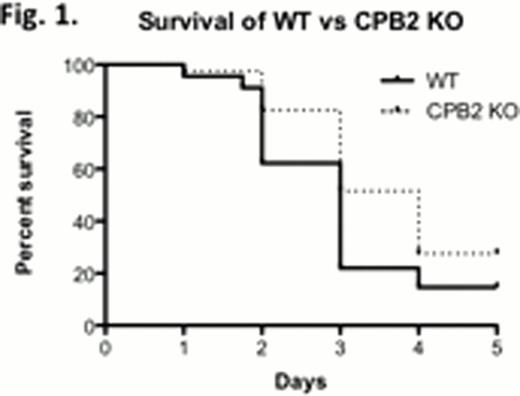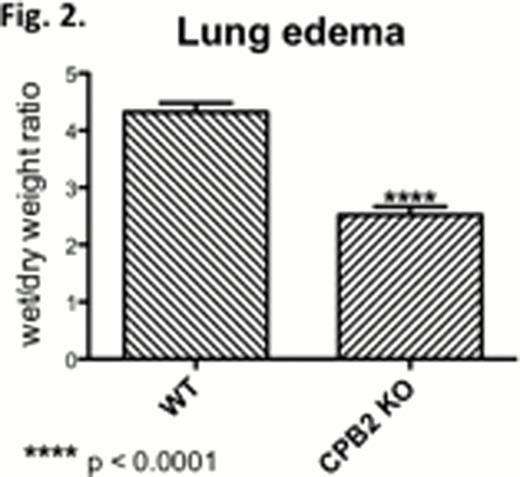Abstract
Abstract 1110
Procarboxypetidase B-2 (pro-CPB2) (also termed thrombin-activatable fibrinolysis inhibitor, TAFI) is activated by the thrombin/thrombomodulin complex to generate a basic carboxypeptidase (CPB2). Fibrin and complement C5a have been shown to be physiological CPB2 substrates, but the role of CPB2 in sepsis is unclear. We hypothesized that in polymicrobial sepsis, the CPB2 KO mice would have exacerbated disease because there would be enhanced activation of C5a, leading to an augmented inflammatory response and tissue injury. To our surprise, in a polymicrobial sepsis model in which the cecum was ligated and punctured (CLP), CPB2 deficient mice had a significant improvement in survival compared to wild type (WT) mice (p = 0.021) (Fig. 1). The median survival time of 3 days in WT mice was extended to 4 days in CPB2 KO mice (p = 0.015). Lung edema as measured by wet/dry lung weight ratio was decreased from 4.4 in the WT mice to 2.5 in the CPB2 KO mice (p = 0.0001) at 48 hr after CLP (Fig. 2). Peritoneal lavage fluid levels of protein and the amount of cell infiltration into the peritoneum at 48 hr was lower in CPB2 KO than WT mice. There was less liver damage assessed as AST and ALT in plasma in the CPB2 KO mice at 48 hr than in WT mice while there was a trend to an increase in BUN suggesting kidney damage in WT mice. There was a greater decrease in the white blood cell count of WT mice than CPB2 KO mice with a drop in lymphocyte numbers accounting for most of that decrease. Inflammatory mediators such as IL-6 and total C5a were lower in plasma from CPB2 KO mice at 6 hr after CLP than in WT plasma. The data suggest that WT mice in this model underwent multiple organ failure leading to their death and the CPB2 deficient mice were protected from the consequences of CLP. Overall these data show that lack of CPB2 protects against polymicrobial sepsis with a concomitant reduction in inflammation. Further studies are underway to determine which substrate is key to the prolonged survival of CPB2 deficient mice in this model.
No relevant conflicts of interest to declare.
Author notes
Asterisk with author names denotes non-ASH members.



This feature is available to Subscribers Only
Sign In or Create an Account Close Modal